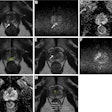
Florida doctors were able to plan a successful surgical procedure on an infant with severe heart defects, using cardiac CT images visualized with a virtual reality (VR) image viewer made from cardboard.
Teegan Lexcen, a 4-month-old from Minnesota, had been diagnosed with hypoplastic left heart syndrome, a hypoplastic aortic arch, double outlet right ventricle, mitral atresia, a ventricular septal defect, and abnormal pulmonary veins draining to the coronary sinus. The infant, who has a healthy twin sister, also lacked a left lung and had no left pulmonary artery. Her case was originally considered to be inoperable.
But physicians at Nicklaus Children's Hospital in Miami thought they could save her. A team led by the hospital's director of cardiovascular surgery, Dr. Redmond Burke, along with Dr. Juan Carlos Muniz, director of cardiac MRI, and Dr. John Rhodes, director of the heart program, used Google Cardboard and other software to convert CT data of the heart into a 3D model that could be viewed on a smartphone.
 From left to right: Dr. Juan Carlos Muniz, Dr. Redmond Burke, and Dr. John Rhodes. Image courtesy of Nicklaus Children's Hospital.
From left to right: Dr. Juan Carlos Muniz, Dr. Redmond Burke, and Dr. John Rhodes. Image courtesy of Nicklaus Children's Hospital.Google Cardboard is a low-cost stereoscopic virtual reality viewer that typically sells for about $19. The viewer is designed to work with a smartphone and dedicated apps to give users a low-budget VR experience.
At Nicklaus Children's Hospital, Teegan's care team converted her CT data into a 3D model using software from 3D software developer Materialise. Sketchfab software was used to upload the model to the Web, where it was converted to a format compatible with the Google Cardboard viewer, the hospital said in a statement.
Armed with the novel surgical planning tool, Burke performed a catheterization in early December. This was followed two days later by a seven-hour open-heart operation to rebuild the infant's aorta with donated human heart tissue, connect her aorta and pulmonary artery, and place a shunt from the right ventricle to the only pulmonary artery.
Although the days and weeks postsurgery have been difficult, the procedure has worked, hospital officials said. Teegan will require two more operations in the years to come, as is typical for children born with hypoplastic heart syndrome. But thanks to the success of the novel procedure, she was able to spend Christmas with her twin sister and the rest of her family in Miami, according to the hospital.



















